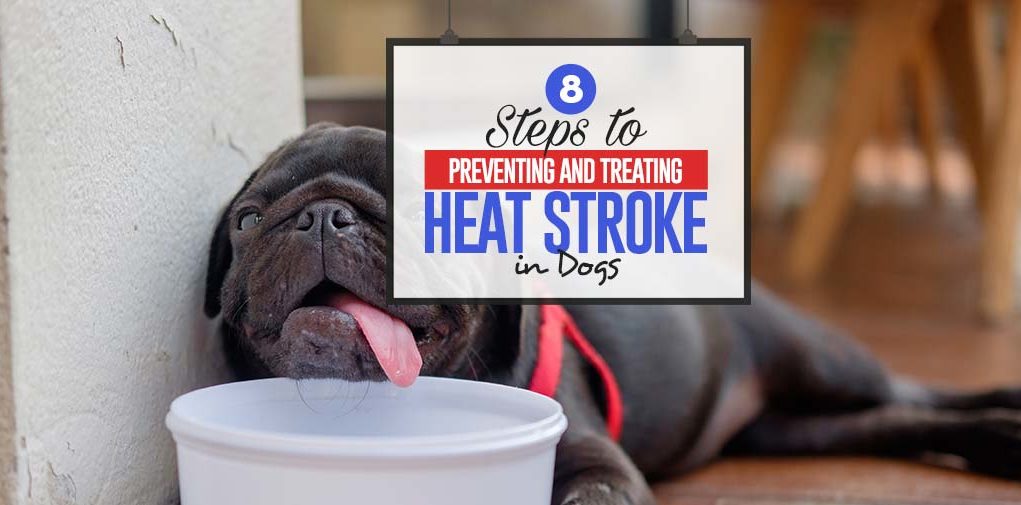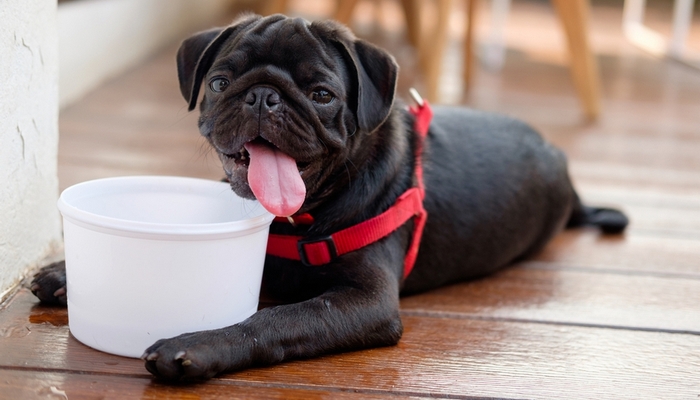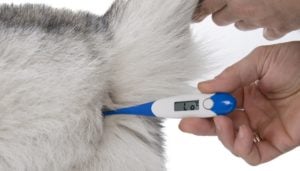Heat stroke can be incredibly dangerous to dogs. Canines are not able to handle heat as well as humans, making them more susceptible to a heat stroke. Heat stroke in dogs can cause permanent organ damage, and can even become fatal.
A moderate level heat stroke (temperature over 104 degrees) can usually be treated within an hour, but a severe one (temperature over 106 degrees) could quickly become fatal. The longer a heat stroke goes untreated, the more at risk your dog is.
Understanding heat stroke in dogs is the first step to preventing your pet from any serious health problems. Most of the time, it's easy to ensure your dog doesn't suffer a heat stroke.
Remember that a dogs cannot handle high temperatures. A warm day for us may be a potentially fatal day for your dog. The following steps provide information you need to effectively deal with and prevent heat stroke in dogs.
RELATED: Top 15 Best Cooling Vests for Dogs to Prevent Heatstroke
8 Steps to Deal With Heat Stroke in Dogs
1 Keep dog indoors whenever possible in hot weather
Anytime weather is predicted to be hot, keep your dog inside. This is crucial at preventing any type of heat stroke in dogs. Canine body temperature can rise very quickly, and they can overheat in serious weather conditions much too fast.
Some breeds are more likely to suffer from heat strokes.
For example, active breeds like Labrador Retrievers will exert energy the entire time they’re outside regardless of how hot the weather is. This puts them at more of a risk. Breeds with shortened faces, such as Shih Tzus, are more susceptible to heat strokes too. Dogs with thicker fur are also at a higher risk. If your dog falls into any of these categories, it is crucial that you keep your pet as cool as possible in the heat.
Keep this chart close by:

The only time you should take your dog outside in severely hot weather is to take him to go to the bathroom. Try to schedule any outdoor activity during early mornings and evenings, as this is when the temperature will be the lowest. Some pet owners choose to use indoor dog litter box toilets instead of going outside when the mercury rises.
If you are unsure of if the weather is safe for your dog, you can check by touching the asphalt. If it is too hot for you to keep your hand on the pavement, it is too hot for your dog to have his paws on it.
When you absolute must leave your dog outside in the heat, do what you can to limit that time. If you can, only have your pets outside in the early morning and late evening, when temperatures are lower.
Bottom Line: To avoid heat stroke in dogs, walk them in the early morning and late evenings before the temperature gets too high for the dogs to tolerate.
2Make sure the dog is safe when staying outside
If you have to keep your dog outside during in high heat, there are steps you can take to make sure he is safe. The first thing to think about is to find an area that is well shaded. Plan ahead and keep in mind that shade will move throughout the day, so make sure there will be adequate shade the entire time Fido is outside.
Water is especially important in hot summer days. Dogs can spill their own water, so it is ideal to have multiple bowls of water for your pet. If you're unsure that you can constantly check on your dog's water bowl, get one of the automatic water bowls instead.
 Put ice in your dog’s water to keep it cooler for longer. Try to keep the water bowls in the shade.
Put ice in your dog’s water to keep it cooler for longer. Try to keep the water bowls in the shade.
While shade is the first key component to preventing heat strokes in dogs, cold water to stay in is another great alternative. Your dog might like a cheap kiddie pool filled with water to splash around in and keep themselves cool. If he is especially active, a kiddie pool is a perfect way to allow the dog to choose when it's time to cool off.
Bottom Line: There must always be a shaded area accessible for your dog. Things like automatic water bowls and cheap kiddie pools are great additions.
3 Never leave your dog in the car
This warning has become a cliche by now, but many pet owners still ignore it. It's imperative to never leave your dog in the car during hot weather. Even if you're leaving your dog in the car with the windows down, air conditioning on, in the shade, and with water, there's a risk of heat stroke in dogs.
Cooler days do not make it safe to leave your dog in the car. A Stanford University study stated that when it is 72 degrees outside, a car’s internal temperature can reach 116 degrees within an hour. When it is 85 degrees, a car can reach 102 degrees in 10 minutes, and 120 degrees in 20 minutes. Dogs are never safe in these conditions.
Remember, dogs aren’t able to cool themselves down like humans can. They can’t sweat, except for minimal amounts from the glands in their foot pads. They can only eliminate heat by panting. Once they can’t pant any longer, they start to overheat, which leads to a heat stroke in dogs. This can happen very quickly when a dog is inside of a car.
Bottom Line: Leaving your dog in a car during hot summer days for any period of time exposes him to the risk of heat stroke.
4 Know the signs of heat stroke in dogs
In case your dog ever suffers from a heat stroke, it is important that you know the symptoms. Heat stroke in dogs can progress very quickly, and the sooner it is caught, the more likely your dog will be able to survive.
- READ THIS: The Ultimate Guide of First Aid for Dogs
Fortunately, dogs display a lot of signs of discomfort when they are suffering from overheating and subsequently from heat strokes. Pay close attention to your canine's behaviors. If you notice any of these signs, begin the treatment steps mentioned below.
Common signs of a heat stroke include:
- Body temperature of 104 or higher
- Rapid heartbeat
- Excessive thirst
- Lethargic behaviors
- Glazed eyes
- Vomiting
- Heavy panting
- Bright red gums and tongue
- Excessive drooling
- Lack of coordination
- Seizures
- Bloody diarrhea
- Unconsciousness
Once you notice these signs in your dog, begin treatment immediately. Even if you aren’t one hundred percent positive your dog had a heat stroke, it is better to be safe than sorry. Heat stroke in dogs can cause lifelong health problems, and cause death.
Bottom Line: Learn all about the signs of heat stroke in dogs and what symptoms to look out for during hot days.
5 First priority is lowering the dog's temperature
Once you think your dog may be experiencing a heat stroke, you must focus on lowering his temperature first and foremost. This should be done before even calling the vet, bringing him to the vet or taking any other actions.
 The quicker you lower your dog’s temperature, the sooner the dog will be able to recover from their heat stroke. The first step in lowering his temperature is to take them into a cooler area.
The quicker you lower your dog’s temperature, the sooner the dog will be able to recover from their heat stroke. The first step in lowering his temperature is to take them into a cooler area.
Going inside an air conditioned house would be most ideal. Running a cool shower over your dog will help bring his body temperature down as well.
REMEMBER: Do not use ICE cold water, only cool or lukewarm, as cold water could send a dog into shock.
Keep giving your dog water to drink, as it help them replenish fluids lost to panting. Placing a cooling fan near your dog will help keep their temperature down. If your dog is unconscious, do not force him into water or force him to drink. It is dangerous to allow any water in the nose or mouth of an unconscious dog. Avoid giving too much water as well, because water intoxication can be dangerous to dogs.
Once your pup’s temperature goes back below 103° Fahrenheit, stop all your efforts to cool him. Cooling him down too much can actually cause other problems, which is why it's best to stop bringing his temperature down at around 103° and move onto the next step.
Bottom Line: Before you do anything else, your first priority should be to lower your dog's body temperature without sending him into shock.
6 Take your dog's temperature every 5 minutes
As soon as you suspect heat stroke in dogs, begin taking their temperature rectally every five minutes. It is imperative that you are able to monitor any changes in temperature. There are ways to take dog's temperature without a thermometer, but using an electronic device will give you the most accurate number.
Continue to track your dog's temperature after you have cooled your dog down, as your pet's temperature can raise back up after cooling.
Your dog’s temperature should slowly go somewhere between 100 degrees and 103 degrees. If it drops below 100 or raises above 103, pay even closer attention to your dog. Continue taking your dogs temperature at regular intervals until you arrive at the vet.
It is a good precautionary measure to learn how to safely take a dog’s rectal temperature before a heat stroke takes place. For the most accurate measurement, you will need a good pet-friendly thermometer, which should always be in your pet's first aid kit.
Here's a video guide that explains how to take dog's temperature with a thermometer:
Bottom Line: Monitoring your dog's temperature is essential when you suspect your canine is suffering from a heatstroke.
7 Take your dog to the vet
When dealing with heat stroke in dogs, and you've already taken the above mentioned first steps, it's time to move on. Take him to the vet as soon as you get his temperature below 103°. On the way to the vet, keep your car’s air conditioning on and windows rolled down. You can even use additional car cooling fans aimed right at your dog to keep his temperature stable.
All of these methods will prevent your dog's temperature from rising again. Call your vet before arriving so they can be ready to treat your canine immediately. Time is key.
Even if his heat stroke symptoms seem mild, or if he seems perfectly okay after cooling down, take him to the vet regardless. Heat stroke in dogs can cause invisible problems, such as brain swelling, kidney failure and blood clotting.
- READ THIS: 7 Ways To Keep Your Dog Cool in Summer
Taking your pet to the vet ensures that they aren’t suffering from any other health problems related to heat stroke in dogs. The vet will mainly treat your dog with intravenous fluid therapy to replace lost fluids and minerals.
Your dog will be monitored for secondary symptoms, such as the ones mentioned above. The vet will continuously monitor your dog’s temperature to ensure it does not go up dangerously high or fall dangerously low.
Bottom Line: Whether you've lowered the dog temperature yourself or not, taking your canine to the vet eventually is necessary.
8 Taking care of your dog after the heatstroke
Heat stroke in dogs of moderate level may not have any long term effects. Your Fido likely will not require any additional care after returning from the vet. Severe heat stroke in dogs can cause permanent organ damage, which will require special care for the rest of your pet’s life, according to studies.
Take a look at this guide from University of Minnesota (PDF), and save it if possible.
Your vet will go over any new precautions you will have to take with your pooch. Dogs who have previously survived a heat stroke are more at risk for future heat strokes too. Once your dog has a heat stroke, you will have to be extremely cautious with him in high temperatures from now on.
Preventing heat stroke in dogs is much easier than treating one. Understand any factors that may make your dog more at risk of this condition, such as breed, activity level, age and weight, and use that to provide him with extra caution. When the temperatures are high, use products that allow your dog to cool down easier, such as dog cooling mats.
Bottom Line: Your dog is more likely to suffer heatstroke again after the first incident. Always keep an eye on him during hot summer days.
In Conclusion
 Heat stroke in dogs can be prevented by limiting how much your pet is outside on hot days, providing adequate shade and water when your dog is outside and by never leaving your canine companion in the car. Dogs will overheat quickly in hot weather conditions. Keeping them inside, in air conditioned room, is the best way to ensure he will not experience a heat stroke. If your dog stays in a crate a lot, get a dog crate cooling fan.
Heat stroke in dogs can be prevented by limiting how much your pet is outside on hot days, providing adequate shade and water when your dog is outside and by never leaving your canine companion in the car. Dogs will overheat quickly in hot weather conditions. Keeping them inside, in air conditioned room, is the best way to ensure he will not experience a heat stroke. If your dog stays in a crate a lot, get a dog crate cooling fan.
If you do suspect a heat stroke in dogs, take action immediately. Check his temperature and look for a temperature of 104° or higher. Begin attempting to cool your dog down as soon as you suspect the condition by going through the above mentioned steps.
Once your dog’s temperature is 103° or lower, take him to a vet. This ensures that the heat stroke is gone, that your dog has the fluids he needs and that he isn't suffering any long term effects.
READ NEXT: 24 Ways To Prevent Heatstroke In Dogs This Summer















